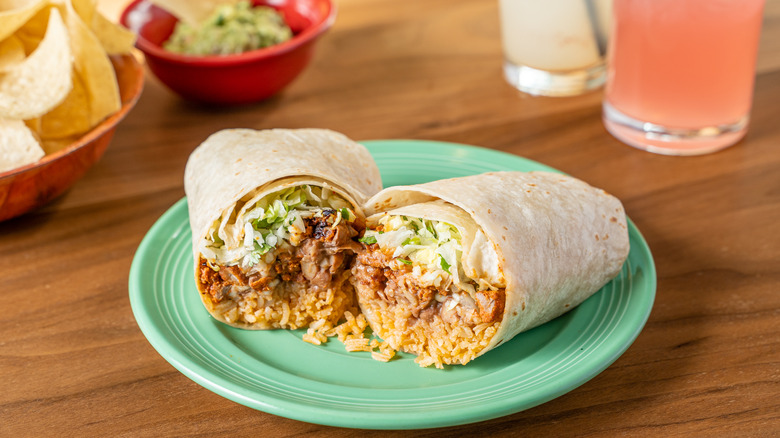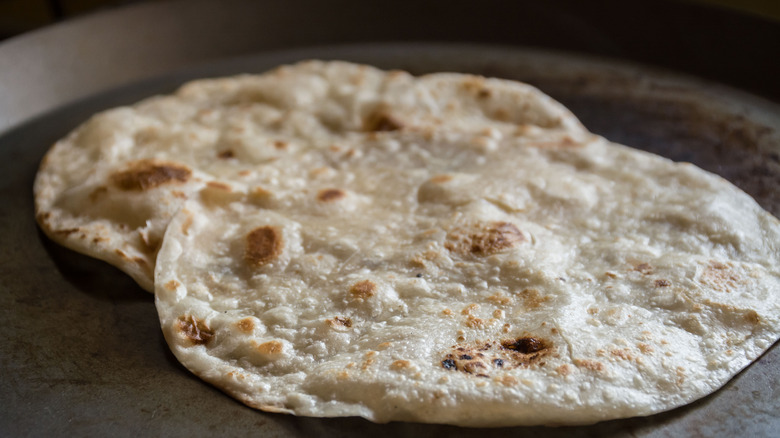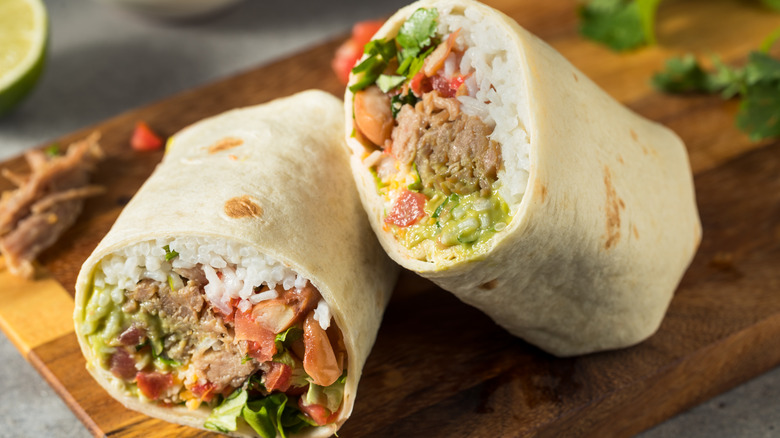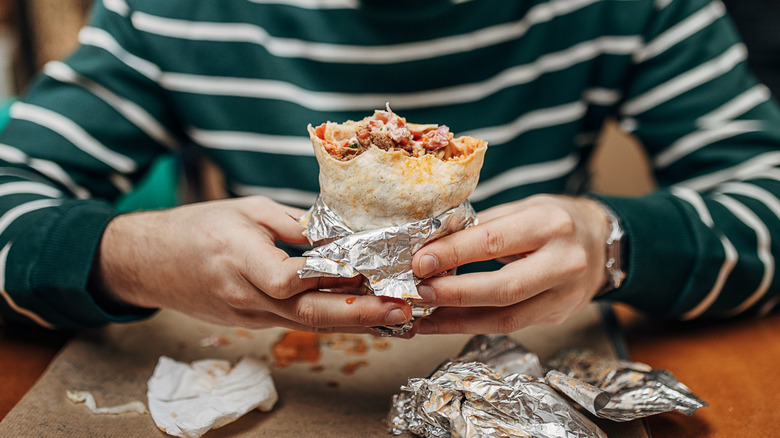How To Tell A Burrito Will Be Disappointing Before Ordering It
There is just something about delicious fillings wrapped in carbs, and the humble burrito — when done well — hits all the right notes. A large flour tortilla can hold any number of combinations of meat, beans, cheese, rice, vegetables, potatoes, eggs, and salsa, but how can you tell if the burrito you are ordering isn't going to meet your expectations? There are four main qualities to consider — tortilla quality, freshness of ingredients, flavor, and structural integrity. While Tex-Mex, Cal-Mex, and Mexican burritos, also sometimes called burros, are the most common, there are also many fusion versions like sushi burritos or tortillas filled with Chinese-American classics.
As with any restaurant or food stand, look at online reviews and visit places that stay busy with customers. Consider the cleanliness and demeanor of employees and owners — do they take pride in the establishment and the food they are serving? When asked a question, do they have real knowledge about the dishes and ingredients? Just because burritos are a popular casual meal doesn't mean that there shouldn't be some real thought and care going into all the components.
Let's start with the tortilla
Depending on the burrito, the texture and size of tortillas vary — but it must be hot. Keep your eyes peeled when you walk into a restaurant. If the person making the burrito is using a tortilla cold, without warming it through, turn around and walk away. That burrito doesn't stand a chance.
Burritos were invented in Mexico though there is some debate as to which Northern Mexican state they actually came from — Chihuahua, Sonora, or somewhere along the Rio Grande River. Ciudad Juarez is where the very first burrito stands and restaurants opened, though establishments founded by Mexican immigrants also opened in Los Angeles, California around the same time.
In much of Northern Mexico, the tortillas are smaller in diameter than what is common in the United States, as well as thicker and chewier. The tortillas are cooked on a hot iron comal, so they get charred spots, and they are usually filled with a meat stew and refried beans. Salsa and toppings like radishes and diced raw onion are served alongside. Sonoran tortillas are large and paper thin, so Sonoran burritos are texturally different from others in Mexico, but they are still typically filled simply.
Tex-Mex burrito tortillas are also quite large and thin, like those used in the Cal-Mex San Francisco Mission-style burritos, which inspired the fast-casual chain Chipotle. No matter the tortilla variety, they should be as fresh as possible and definitely heated up, so they are pliable and tasty.
The meat of the issue: burrito ingredients
A tortilla can certainly make or break a burrito, but so can the fillings. Every ingredient should be able to stand alone and then be combined together to create something greater than the sum of its individual parts. If the restaurant is such that you can see them preparing the burrito, take a gander at the containers the employee is scooping from.
Do the beans look like they are straight out of the can? Is the lettuce wilted or crisp? Is the pico de gallo vibrant or waterlogged? Do prepared grilled meats look dry rather than succulent? Does the rice appear to be flecked with seasoning? If you are ordering more of a Northern Mexican- or Los Angeles-style burrito, is the meat stew, or guisado, rich, thick, and loaded with tender chunks of meat — or is it watery and sparse? These visual cues help to indicate both freshness and what the flavor may be.
A burrito must hold its shape
Without structural integrity, your burrito enjoyment will be significantly diminished. Part of that has to do with proper folding technique and a tight foil wrap — good burrito etiquette is all about preserving the wrapper. Another factor is the ingredients themselves. The filling cannot be too wet (or too dry — but for entirely different reasons), and it needs to have components that act as a glue to hold everything together. Ingredients like rice, beans, and grilled meats or vegetables provide heft but need other components so that the entire burrito holds together.
For example, a burrito with whole black beans, rice, cubes of steak, and salsa will crumble apart when you bite into it. Adding things like refried beans, melted cheese, guacamole, shredded meats such as barbacoa or pulled chicken, or stews like picadillo or carne guisada can help to unify your burrito. Sour cream, Mexican crema, and Tex-Mex queso can also help hold things together, but if the proportions are off, they can introduce too much moisture.
Fresh ingredients provide crunch and bright flavors, but an overwhelming amount of lettuce, cabbage, tomato, onion, or salsa can release water and turn your burrito into a soggy mess, especially once warmed by the other ingredients. When considering menu descriptions or building your own, make sure your burrito has a balance of textures. Because, unless you're ordering a wet burrito, you're going to be eating this with your hands.




